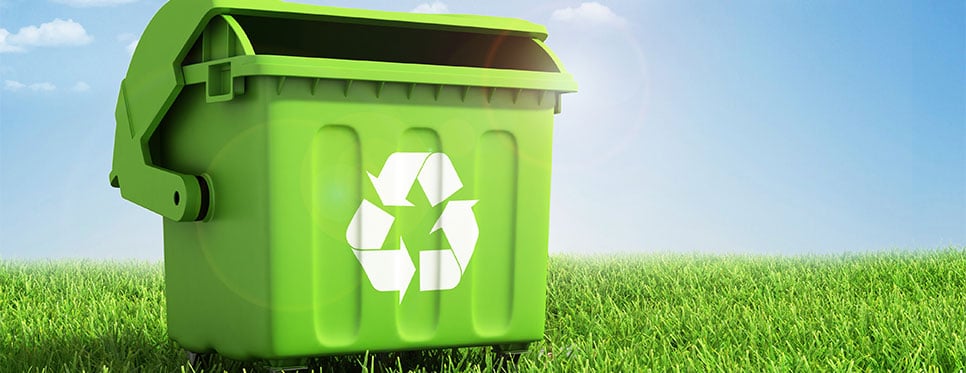
Waste Diversion Legislation – An Overview
According to the United States. Environmental Protection Agency (EPA), there were 258 million tons of municipal solid waste (MSW) generated in the United States in 2014 – and of this amount, 89 million tons were either recycled or composted, which equated to a 34.6% average recycling rate for the nation.
Depending on what part of the country you live in, the recycling rate may be higher or lower than this national average – and there may or may not be legislation and mandates which codify the desired recycling rate.
Opinions on recycling vary widely depending on where people live. According to an article from Pew Research, 28% of Americans say that their local communities’ social norms strongly encourage recycling; 22% of Americans say that their communities do not encourage recycling; and the remaining 50% live someplace where opinions are somewhere in the middle.
Mandatory or Volunteer Recycling – Which Approach Works Better?
These results are probably to be expected. For the most part recycling in America is a volunteer activity, which means that individual businesses and residents are the ones to decide on initiating a waste diversion and recycling program, and then they take the necessary steps to reduce the amount of waste generated by their business or home.
It has been generally accepted that there are intrinsic financial benefits to waste reduction. It stands to reason that the less waste generated, the less money is required to pay for a service to haul the waste away to the landfill. In some jurisdictions, the tipping fees for a load of recyclables/compostables is less expensive than the tipping fees for a load of waste, and this fee structure helps to promote local waste diversion efforts.
However, sometimes the desire of a business or individual to recycle outpaces the local infrastructure needed to handle these waste diversion efforts. As a result, local states or municipalities have stepped in to enact legislation to help “create the market” for community waste diversion efforts.
State Mandates – A Look at Recycling and Organic Waste Ordinances Throughout the U.S.
Recycling ordinances are in place in many states throughout the country, and these laws are supplemented by additional mandates in several cities and municipalities as well. These ordinances vary in scope and materials covered, and depending on the local community acceptance and infrastructure, there are varying degrees of effectiveness.
In addition to these more long-standing recycling ordinances which cover familiar recyclable items such as bottles and paper, there are now additional requirements which have been enacted in order to divert organic waste, such as landscape waste and food scraps from the landfill. In fact, diverting food scraps in being seen as the next frontier in waste diversion!
Why? According to an article in BioCycle Magazine, over 40% of the food produced in the U.S. is wasted annually, and according to the EPA, these food scraps represent 38.4 million tons of waste or 14.9% of the total MSW generated. Placing an emphasis on food scrap diversion has been demonstrated to increase the amount of food donated to food banks, and can have a beneficial impact on increasing the lifespan of local landfills.
According to an article in BioCycle Magazine, at this time there are five states with waste diversion legislation focused on this organic waste, along with a few other additional municipalities. Four of the states with organic waste recycling mandates are in the Northeast and include Connecticut, Massachusetts, Rhode Island and Vermont. These Northeast states have been joined by California and municipalities such as Portland, OR; Seattle, WA; San Francisco, CA; Austin, TX; and New York NY who have also enacted legislation requiring the diversion of organic waste from the landfills.
State of California Mandates
The State of California and many of its cities such as the City of San Diego, City of Los Angeles and City of San Francisco, have enacted several pieces of legislation over the years to promote recycling efforts in the state. In this ongoing effort to increase waste diversion rates since the 1990’s, the State of California has enacted the following legislation:
AB 939: Known as the California Integrated Waste Management Act. This legislation was enacted in 1989 when diversion rates were around 10%, and it established the requirement for all cities, counties, and approved regional solid waste management agencies to implement programs to successfully divert 25% of their solid waste by 1995, and 50% by 2000. This legislation was supplemented by AB 75 in 1999, which requires state agencies to implement an integrated waste management plan.
AB 341: The diversion percentage requirements for AB 939 were updated and increased in 2011 with the passage of AB 341, which raised the diversion bar for the State as a whole to 75% by the year 2020. It now also requires any commercial buildings which generate 4 cubic yards of waste per week to implement a recycling program. This legislation does not specifically increase the diversion rates for cities and counties (whose goal remains at 50%), and is intended to augment the Mandatory Commercial Recycling measures adopted with AB 32 legislation focused on reducing Greenhouse Gas Emissions (GHG).
AB 1826: The topic of organic waste diversion is addressed by AB 1826 (also known at Mandatory Commercial Organics Recycling, or MORe), which was signed into law in 2014, and states that any commercial building or multifamily residential dwelling consisting of five or more units is required to make arrangements to engage in an organics recycling services. This legislation required buildings that generated 8 cubic yards of organics waste a week to be in compliance by April 2016; those generating 4 cubic yards of organic waste per week to be in compliance by January 2017; those generating 4 cubic yards of total waste per week to be in compliance by January 2019; and in the Summer/Fall of 2021, it is possible that those generating 2 cubic yards of total waste per week will be required to engage in an organics recycling service.
Recycling – The Future
The bottom line is that recycling and waste diversion activities – whether voluntary or mandated – will continue to be an important topic for facility management and sustainability professionals moving forward, and WAXIE stands ready to partner with those seeking to implement innova tive and laborsaving solutions to divert waste from the landfills.


